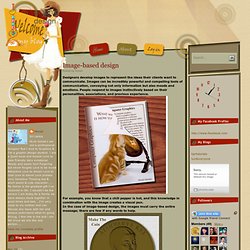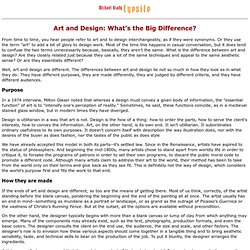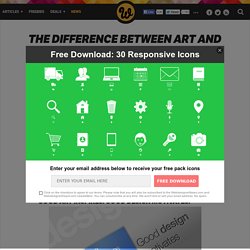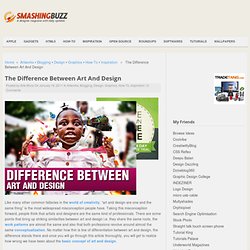

What is Graphic Design? What is graphic design? Graphic design, also known as communication design, is the art and practice of planning and projecting ideas and experiences with visual and textual content.

The form of the communication can be physical or virtual, and may include images, words, or graphic forms. The experience can take place in an instant or over a long period of time. The work can happen at any scale, from the design of a single postage stamp to a national postal signage system, or from a company’s digital avatar to the sprawling and interlinked digital and physical content of an international newspaper. It can also be for any purpose, whether commercial, educational, cultural, or political. Design that’s meant to be experienced in an instant is the easiest to recognize and has been around the longest. The design of books and magazines also has a long history. Many designers also produce systems that are meant to be experienced over time, but aren’t confined to the making of objects.
Image-based design. Designers develop images to represent the ideas their clients want to communicate.

Images can be incredibly powerful and compelling tools of communication, conveying not only information but also moods and emotions. People respond to images instinctively based on their personalities, associations, and previous experience. For example, you know that a chili pepper is hot, and this knowledge in combination with the image creates a visual pun.In the case of image-based design, the images must carry the entire message; there are few if any words to help.
These images may be photographic, painted, drawn, or graphically rendered in many different ways. Image-based design is employed when the designer determines that, in a particular case, a picture is indeed worth a thousand words. Graphic Design History Timeline. Graphic Design History. Teach Yourself Graphic Design: A Self-Study Course Outline. Fortunately, it isn’t required to go to design school in order to be a graphic designer.

A good foundation in graphic design history, theory, and practical application will help you hit the ground running. There are plenty of resources available in which you can learn graphic design on your own. Don’t set your expectations to high at first, as it will take enthusiastic study for years to become great. You can do it though! If you would like to learn graphic design from the ground up, through self directed study, then this article lists some great resources that will get you started with your design education. 1. There are a few graphic design principles that effect every project you’ll create.
Graphic Design Basic Elements. The Basics of Graphic Design. Graphic Design Graphic design is the process of creating the appearance of a publication, presentation, or web site in an attractive, logical manner. When done successfully, it attracts attention, adds value to a message, enhances readership and readability, simplifies, organizes, provides selective emphasis, and creates unity. Steps in the Graphic Design Process: Analyze the audience. Determine the purpose of your message. Decide where and how your message will appear (whether it will be a printed publication, presentation, or web site).
Establish goals. Organize text and graphics. Choose an appropriate format and layout. Select appropriate typefaces, type sizes, type styles, and spacing. Add and manipulate graphics. Proofread Refine and fine-tune. Creating Effective Layouts Layout Guidelines. Art Inspired / Graphic Design and Advertising. The Universal Arts of Graphic Design | Off Book | PBS The Fundamental Elements of Design The Fundamental Elements of Design from Erica Gorochow on Vimeo.

History of Graphic Design Want to know how to design? Learn The Basics. Teach Yourself Graphic Design: A Self-Study Course Outline 50 Totally Free Lessons in Graphic Design Theory While many of us can create something that looks good in Photoshop or attractive when spliced into CSS, but do we actually understand the design theory behind what we create? The Key To Media's Hidden Codes: Colors, camera angles and logos in the media can all prompt immediate associations with emotions, activities and memories. Click here for Logos Click here for Business Cards Click here for Packaging You may also be interested in: 25 Useful Videos and Presentations for Designers 10 Web Typography Rules Every Designer Should Know.
The History of Graphic Design Art. Between Art and Design. Several months ago, I read an article on WebDesigner Depot entitled “The Difference Between Art and Design”.

It was a fascinating piece that attempted to establish a clear distinction between these two very closely related concepts. Over the past few months, the article has really stuck with me and caused me to do a lot of thinking. I would like to expand on some of those thoughts here. Art and Design. Art and Design: What’s the Big Difference?

From time to time, you hear people refer to art and to design interchangeably, as if they were synonyms. Or they use the term "art" to add a bit of glory to design work. Most of the time this happens in casual conversation, but it does tend to confuse the two terms unnecessarily because, basically, they aren't the same. The Difference Between Art and Design.
The subject of what separates art and design is convoluted and has been debated for a long time.

Artists and designers both create visual compositions using a shared knowledge base, but their reasons for doing so are entirely different. Some designers consider themselves artists, but few artists consider themselves designers. So what exactly is the difference between art and design? In this post, we’ll examine and compare some of the core principles of each craft. This is a subject that people have strong opinions about, and I’m looking forward to reading the various points of view in the comments.
This post isn’t a definitive guide, but rather the starting point for a conversation, so let’s be open-minded! Good Art Inspires. Perhaps the most fundamental difference between art and design that we can all agree on is their purposes. The Difference Between Art And Design Like many other common fallacies in the world of creativity, “art and design are one and the same thing” is the most widespread misconception people have.

Taking this misconception forward, people think that artists and designers are the same kind of professionals. There are some points that bring up striking similarities between art and design i.e. they share the same roots, the work patterns are almost the same and also that both professions revolve around almost the same conceptualization.